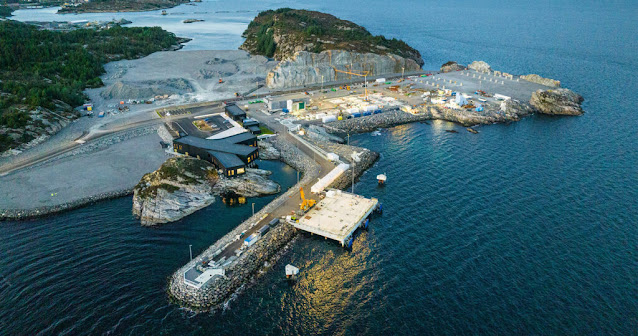In a groundbreaking milestone for global climate efforts, the Northern Lights consortium, a collaboration between energy giants Equinor, Shell, and TotalEnergies, announced on August 25, 2025, that it has successfully injected carbon dioxide (CO2) into the North Sea seabed, marking the launch of the world’s first commercial carbon capture and storage (CCS) service. This pioneering project aims to capture CO2 emissions from industrial smokestacks across Europe, transport them to a specialized facility in Norway, and store them permanently beneath the seabed to prevent their release into the atmosphere. The achievement represents a significant step forward in the fight against climate change, demonstrating the feasibility of large-scale CCS as a tool to reduce greenhouse gas emissions. However, challenges such as high costs and limited adoption highlight the complexities of scaling this technology to meet global climate goals. This article explores the details of the Northern Lights project, its implications for the energy and environmental sectors, and the broader context of CCS in the global effort to combat climate change.
The Northern Lights Project: A Pioneering Achievement
The Northern Lights project, launched by Equinor, Shell, and TotalEnergies, is a landmark initiative designed to address one of the most pressing challenges of the 21st century: reducing CO2 emissions from hard-to-abate industrial sectors. The project’s core mission is to capture CO2 emitted from industrial facilities across Europe, transport it via specialized ships to a terminal in Norway, and store it permanently in geological formations beneath the North Sea seabed. This process, known as carbon capture and storage (CCS), is seen as a critical technology for achieving net-zero emissions, particularly for industries like cement, steel, and chemical production, which are difficult to decarbonize through electrification or renewable energy alone.
On August 25, 2025, Northern Lights managing director Tim Heijn announced a major milestone: “We now injected and stored the very first CO2 safely in the reservoir.” This statement confirmed that the project’s infrastructure—comprising ships, processing facilities, pipelines, and injection wells—is fully operational, marking the transition from development to commercial operation. The successful injection of CO2 into a reservoir 2.6 kilometers beneath the North Sea seabed is a testament to years of planning, investment, and technological innovation by the consortium and its partners.
The process begins with the capture of CO2 at industrial sites, where it is separated from other gases emitted during production. The captured CO2 is then liquefied to facilitate transportation. Specialized ships transport the liquid CO2 to the Oygarden terminal near Bergen on Norway’s west coast, where it is stored temporarily in tanks. From there, it is pumped through a 110-kilometer pipeline to an offshore injection site, where it is injected into a geological reservoir deep beneath the seabed. The reservoir, carefully selected for its geological stability, ensures that the CO2 remains securely stored for thousands of years, preventing its release into the atmosphere.
The first CO2 shipment processed by Northern Lights came from Heidelberg Materials’ cement plant in Brevik, southeastern Norway. Cement production is one of the most carbon-intensive industries, accounting for approximately 8% of global CO2 emissions due to the chemical processes involved in producing clinker, the primary component of cement. By capturing and storing emissions from the Brevik plant, Northern Lights is demonstrating the potential of CCS to decarbonize industries that are critical to global infrastructure but challenging to transition to low-carbon alternatives.
The Role of CCS in Global Climate Efforts
The successful launch of the Northern Lights project comes at a critical time for global climate efforts. The United Nations Intergovernmental Panel on Climate Change (IPCC) and the International Energy Agency (IEA) have repeatedly emphasized the importance of CCS in achieving the Paris Agreement’s goal of limiting global warming to 1.5°C above pre-industrial levels. According to the IEA, CCS could account for up to 15% of the emissions reductions needed by 2050 to achieve net-zero emissions, particularly in industries where alternative decarbonization strategies, such as renewable energy or electrification, are not feasible.
Hard-to-abate sectors like cement, steel, and chemical production are prime candidates for CCS. These industries rely on high-temperature processes or chemical reactions that inherently produce CO2, making them difficult to decarbonize without capturing and storing emissions. For example, the production of cement involves the calcination of limestone, which releases CO2 as a byproduct, in addition to emissions from burning fossil fuels to heat kilns. Similarly, steel production generates significant CO2 through the use of coal in blast furnaces. CCS offers a way to mitigate these emissions by capturing CO2 at the source and preventing it from entering the atmosphere.
The Northern Lights project is a pioneering example of how CCS can be implemented at scale. With an initial storage capacity of 1.5 million tonnes of CO2 per year, the project is equivalent to removing the emissions of approximately 300,000 gasoline-powered cars annually. The consortium plans to expand this capacity to 5 million tonnes by 2030, a target that would significantly enhance its impact. This expansion aligns with global ambitions to scale up CCS infrastructure, with the IEA estimating that the world will need to store 7.6 billion tonnes of CO2 annually by 2050 to meet climate goals.
The Technical and Operational Framework
The Northern Lights project is a marvel of engineering and logistics, integrating multiple components to create a seamless CCS value chain. The process begins at industrial facilities, where CO2 is captured using technologies such as amine scrubbing, which separates CO2 from other gases in smokestack emissions. The captured CO2 is then compressed and cooled to a liquid state, making it easier to transport and store. This liquefaction process is energy-intensive but critical to the efficiency of the overall system.
Once liquefied, the CO2 is loaded onto specialized ships designed to transport large volumes of the gas safely. These ships, equipped with advanced containment systems, sail to the Oygarden terminal near Bergen, a state-of-the-art facility that serves as the hub of the Northern Lights project. At Oygarden, the CO2 is transferred to storage tanks, where it is held temporarily before being pumped through a 110-kilometer subsea pipeline to the injection site. The pipeline, constructed to withstand the harsh conditions of the North Sea, represents a significant engineering achievement, ensuring the safe and efficient transport of CO2 to its final destination.
The injection site, located 2.6 kilometers beneath the seabed, is a carefully selected geological formation known as a saline aquifer. These formations, composed of porous rock filled with saltwater, are ideal for CO2 storage due to their capacity to hold large volumes of gas and their geological stability. The CO2 is injected under high pressure, where it is trapped by impermeable rock layers, preventing its release into the atmosphere. Extensive monitoring systems, including seismic sensors and pressure gauges, are in place to ensure the integrity of the storage site and detect any potential leaks.
The successful injection of the first CO2 shipment from Heidelberg Materials’ Brevik plant marks the completion of this complex value chain. The project’s operational success is a testament to the collaboration between Equinor, Shell, and TotalEnergies, as well as the support of the Norwegian government, which has provided significant funding and regulatory backing. The government’s investment reflects Norway’s long-standing commitment to CCS, building on its experience with projects like Sleipner and Snøhvit, which have stored CO2 beneath the North Sea since the 1990s.
Challenges and Limitations of CCS
Despite its promise, CCS faces significant challenges that have slowed its adoption globally. One of the primary barriers is cost. The process of capturing, transporting, and storing CO2 is expensive, requiring substantial upfront investment in infrastructure and ongoing operational costs. For industries like cement and steel, the cost of CCS can be prohibitive without government subsidies or financial incentives. In Europe, many companies find it cheaper to purchase carbon permits through the Emissions Trading System (ETS), which allows them to emit CO2 at a lower cost than investing in CCS technology.
Northern Lights has signed only three commercial contracts to date, reflecting the limited uptake of CCS among European industries. These contracts include a Yara ammonia plant in the Netherlands, two of Ørsted’s biofuel plants in Denmark, and Stockholm Exergi’s thermal power plant in Sweden. While these agreements demonstrate the project’s potential, they also highlight the challenge of scaling CCS to meet global demand. The consortium’s current capacity of 1.5 million tonnes per year is a fraction of the billions of tonnes needed annually to achieve net-zero emissions, underscoring the need for broader adoption and investment.
Another challenge is public perception. CCS has faced skepticism from environmental groups and communities, who question its safety and effectiveness. Concerns about potential CO2 leaks from storage sites, the energy intensity of capture processes, and the reliance on fossil fuel infrastructure have led some to argue that CCS is a distraction from renewable energy solutions. However, proponents, including the IPCC and IEA, counter that CCS is a necessary complement to other decarbonization strategies, particularly for industries with no viable alternatives.
The Northern Lights project addresses these concerns through rigorous safety and monitoring protocols. The selection of a stable geological reservoir, combined with advanced monitoring technology, minimizes the risk of leaks. The project also benefits from Norway’s decades of experience in offshore CO2 storage, which has established a strong track record of safety and reliability. Nevertheless, building public trust and securing additional contracts will be critical to the project’s long-term success.
The Role of Government Support
The Norwegian government’s backing has been instrumental in bringing the Northern Lights project to fruition. Recognizing the importance of CCS in achieving its climate goals, Norway has invested heavily in the project, providing funding for infrastructure development and regulatory support. The government’s commitment is part of a broader strategy to position Norway as a global leader in CCS, leveraging its expertise in offshore oil and gas to develop new technologies and business models.
The government’s support has also helped mitigate the financial risks associated with CCS. By subsidizing the Northern Lights project, Norway has reduced the cost burden on private companies, making it more feasible for industries to adopt the technology. This model of public-private partnership could serve as a blueprint for other countries looking to scale CCS, particularly in regions with significant industrial emissions but limited financial resources.
The expansion of the project’s capacity to 5 million tonnes by 2030 is a key goal, supported by additional government funding and anticipated contracts with European industries. This growth will require continued collaboration between the consortium, the government, and international partners, as well as advancements in capture and storage technologies to reduce costs and improve efficiency.
Global Implications and Future Prospects
The successful launch of the Northern Lights project has significant implications for global climate efforts. As the world’s first commercial CCS service, it sets a precedent for how CCS can be implemented at scale, offering a model for other countries and regions. The project’s cross-border approach, capturing CO2 from multiple European countries and storing it in Norway, demonstrates the potential for international cooperation in addressing climate change. This collaborative model could inspire similar initiatives in regions like the Gulf of Mexico, the Middle East, or Asia, where industrial emissions are significant.
The project also highlights the importance of integrating CCS into broader decarbonization strategies. While renewable energy, energy efficiency, and electrification are critical components of the transition to a low-carbon economy, CCS addresses emissions that cannot be eliminated through these methods. By targeting hard-to-abate sectors, Northern Lights is paving the way for a more comprehensive approach to emissions reduction, ensuring that no industry is left behind in the quest for net-zero.
Looking ahead, the success of Northern Lights will depend on several factors. Securing additional contracts with European industries is a priority, as the project’s current client base is limited. Reducing the cost of CCS through technological innovation and economies of scale will also be critical, as will building public and industry confidence in the technology’s safety and effectiveness. International collaboration, supported by organizations like the Global CCS Institute and the IEA, could accelerate these efforts by sharing best practices and fostering investment.
The Broader Context: Climate Change and Industry
The launch of Northern Lights comes at a pivotal moment in the global fight against climate change. The IPCC’s 2023 report warned that global emissions must peak before 2025 and decline by 43% by 2030 to limit warming to 1.5°C. With emissions continuing to rise in many sectors, technologies like CCS are increasingly seen as essential to bridging the gap between current trends and climate targets. The cement industry, which accounts for a significant share of global emissions, is a prime example, as are steel, chemicals, and ammonia production, all of which are targeted by Northern Lights.
The project’s focus on cross-border collaboration also addresses a key challenge in global climate policy: the uneven distribution of emissions and storage capacity. While many countries produce significant industrial emissions, not all have suitable geological formations for CO2 storage. Norway’s North Sea reservoirs, with their vast capacity and proven stability, offer a solution, enabling countries like the Netherlands, Denmark, and Sweden to decarbonize their industries without developing their own storage infrastructure.
The Northern Lights project also has economic implications. By establishing Norway as a hub for CCS, the project creates opportunities for job creation, technological innovation, and export of expertise. The growth of the CCS industry could stimulate investment in related sectors, such as renewable energy, hydrogen production, and carbon-negative technologies, further enhancing Norway’s role in the global energy transition.
Challenges for Scaling CCS Globally
Scaling CCS globally will require overcoming several hurdles. In addition to cost and public perception, the development of CCS infrastructure demands significant coordination between governments, industries, and international organizations. Regulatory frameworks must be harmonized to facilitate cross-border CO2 transport, and financial incentives, such as carbon pricing or subsidies, must be expanded to make CCS viable for more industries.
The limited number of contracts signed by Northern Lights highlights the challenge of convincing industries to invest in CCS. In Europe, the ETS provides a mechanism for companies to offset emissions through carbon permits, but the cost of these permits is often lower than the cost of CCS. Increasing the price of carbon permits or introducing targeted subsidies could incentivize greater adoption, as could international agreements to share the costs of CCS infrastructure.
Technological innovation is another critical factor. Advances in capture technologies, such as next-generation solvents or membrane-based systems, could reduce the energy intensity and cost of CCS, making it more accessible to a wider range of industries. Similarly, improvements in transport and storage technologies could enhance the efficiency and safety of CCS operations, further boosting confidence in the technology.
Conclusion: A Milestone for Climate Action
The successful injection of CO2 into the North Sea seabed by the Northern Lights consortium on August 25, 2025, marks a historic milestone in the global fight against climate change. As the world’s first commercial CCS service, the project demonstrates the feasibility of capturing, transporting, and storing CO2 at scale, offering a viable solution for decarbonizing hard-to-abate industries. The collaboration between Equinor, Shell, TotalEnergies, and the Norwegian government highlights the power of public-private partnerships in driving innovation and achieving climate goals.
While challenges such as high costs, limited adoption, and public skepticism remain, the Northern Lights project sets a precedent for how CCS can be integrated into broader decarbonization strategies. Its cross-border approach, targeting emissions from multiple European countries, underscores the importance of international cooperation in addressing a global challenge. As the project expands its capacity and secures new contracts, it has the potential to transform the way industries manage their emissions, paving the way for a low-carbon future.
For the global climate community, Northern Lights is a beacon of hope, demonstrating that ambitious solutions are within reach. However, its success will depend on continued investment, innovation, and collaboration. As the world races to meet the Paris Agreement targets, projects like Northern Lights will play a critical role in ensuring that no sector—and no country—is left behind in the transition to a sustainable future.






